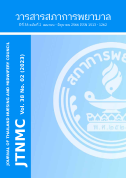The Experiences of Self-Directed Learning in Nursing Practicum of Nursing Students
DOI:
https://doi.org/10.60099/jtnmc.v38i02.261212Keywords:
experience, self-directed learning, nursing student, nursing practicum, descriptive qualitative studyAbstract
Introduction Teaching and learning in nursing practicum, nursing students are expected to apply their self-directed learning skills to seek more information, enhance their nursing knowledge, and develop clinical skills to plan and provide nursing care to their patients properly. However, self-directed learning is a multifaceted concept that should not be approached from a single perspective, especially in clinical practice for nursing practicum. Understanding the self-directed learning process from a learner’s perspective can help improve the teaching plans tailored to the learners, which led to this research.
Objective To explore experiences of self-directed learning in nursing practicum of nursing students.
Design Descriptive qualitative study Methodology Informants were third-year nursing students at a school of nursing in Bangkok who had completed the Adult and Gerontological Nursing 2 practicum. The informants were purposively selected based on the inclusion criteria. Data were collected using two focused group interviews and individual in-depth interviews. Each focused group consisted of six informants. Nineteen informants volunteered for in-depth interviewing. Data were analyzed using content analysis. Creditability and confirmability were explained in the analysis process and findings of the study. Novel-like written reports with quotations were applied to narrate the informants’ self-directed learning experiences during the practicum.
Findings The experiences of self-directed learning in nursing practicum in this study were captured in three main categories: self-starting, struggling with limited time, and pay-off. Self-starting was explained with the subcategories of self-interest and being stimulated by specific situations. Struggling with limited time was driven by pre-clinical skill training, seeking convenient resources, attempted multitasking, and must succeed. Pay-off was described with two subcategories: feelings of pride and having new-found skills. Feelings of pride explained the experiences of self-accomplishment once gaining more knowledge, feeling confident, being ready to practice, and finally achieving better grades. New-found skills were described as the discovering of new skills gained after the self-directed learning process by learners including organizing and managing their daily tasks as well as realizing their responsibilities towards various life areas.
Recommendations Findings from this study suggest a need for curriculum development and adjustment to the teaching plan for nursing practicums to maximize learning outcomes of the learners and the study course. The key success factors include providing students more time to go over the learning assignments, ensuring proper preparation of pre-clinical skills and reducing excessive clinical workloads. Future research on the development of a self-learning assessment tool specific to nursing practicums followed by testing its generalizability is recommended.
Downloads
References
Knowles MS. Inquiry project No.2: what is self-directed learning? In: Knowles MS, editor. Self-directed learning: a guide for learners and teachers. New York; Association Press; 1975. p.18-22.
Gibbons M. Chapter 1: the case for self-directed learning. In: Gibbons M, editor. The self-directed learning handbook: Challenging adolescent students to excel. San Francisco: John Wiley & Sons; 2002.p.1-13.
Office of the Education Council. National educational standards B.E. 2561 [Internet]. Bangkok: Education Standards Division; 2019 [cited 2023 Jan 9]. Available from:https://www.onec.go.th/th.php/book/BookView/1659
Srisavarindhira Thai Red Cross Institute of Nursing. Bachelor of Nursing Science Program (Revised Curriculum 2017). Bangkok: Srisavarindhira Thai Red Cross Institute of Nursing; 2017. (in Thai)
Nazarianpirdosti M, Janatolmakan M, Andayeshgar B, Khatony A. Evaluation of self-directed learning in nursing students: a systematic review and meta-analysis. Educ Res Int. 2021 Nov 20;(2):1-8.doi:10.1155/2021/2112108.
Olivier J. Online access and resources for open self-directed learning in Africa. In: Burgos D, Olivier J, editors. Radical solutions for education in Africa: open education and self-directed learning in the continent. Singapore: Springer; 2021. p.1-16. Available from: https://doi.org/10.1007/978-981-16-4099-5_2.
Kerr D, Ratcliff J, Tabb L, Walter R. Undergraduate nursing student perceptions of directed self-guidance in a learning laboratory: An educational strategy to enhance confidence and workplace readiness. Nurse Educ Pract. 2020 Jan;42:102669. doi: 10.1016/ j.nepr.2019.102669. Epub 2019 Nov 19. PMID: 31786373.
Doyle L, McCabe C, Keogh B, Brady A, McCann M. An overview of the qualitative descriptive design within nursing research. J Res Nurs. 2020 Aug;25(5):443-455. doi: 10.1177/ 1744987119880234. Epub 2019 Dec 18. PMID: 34394658
Lambert VA, Lambert CE. Qualitative descriptive research: an acceptable design. Pacific Rim Int J Nurs Res [Internet]. 2012 [cited 2023 Jan 9]; 16(4):255-6. Available from:https://he02.tci-thaijo.org/index.php/PRIJNR/article/view/5805
Holloway I, Galvin K. Qualitative research in nursing and healthcare. 4thed. Chichester, West Sussex: John Wlley & Sons; 2017. p. 287-302.
Lincoln YS, Guba EG. Naturalistic inquiry. Newbury Park (CA): SAGE; 1985.
Garrison DR. Self-directed learning: toward a comprehensive model. Adult Educ Q.1997;48(1): 18-33. doi:10.1177/074171369704800103.
Loeng, S. Self-Directed Learning: A Core Concept in Adult Education, Education Research International, vol. 2020, Article ID 3816132: 1-12, 2020. Available from: https://doi.org/10.1155/2020/3816132
Knowles MS, Holton III EF, Swanson RA. The adult learner: the definitive classic in adult education and human resource development. 8th ed. London: Routledge; 2015.
Sharif F, Masoumi S. A qualitative study of nursing student experiences of clinical practice. BMC Nurs. 2005 Jan;4:6. doi: 10.1186/1472- 6955-4-6. PMID: 16280087.
Bhandari B, Chopra D, Singh K. Self-directed learning: assessment of students’ abilities and their perspective. Adv Physiol Educ. 2020 Sep 1;44(3):383-6. doi: 10.1152/advan.00010.2020. PMID: 32628525.
Du Toit-Brits C. A focus on self-directed learning: the role that educators’ expectations play in the enhancement of students’ self-directedness. S Afr J Educ 2019;39(2):1-11. doi:10.15700/saje. v39n2a1645
Du Toit-Brits C. Towards a transformative and holistic continuing self-directed learning theory. S Afr J High Educ 2018;32(4):51-65. doi: 10.20853/32-4-2434
A S E A N U n i v e r s i t y N e t w o r k . A S E A N university network quality assurance: guide to AUN-QA assessment at programme level version 4.0. Bangkok: ASEAN University Network; 2020.
Miller GE. The assessment of clinical skills/ competence/performance. Acad Med. 1990 Sep;65(9 Suppl):S63-7. doi: 10.1097/00001888-199009000-00045. PMID: 2400509.
Downloads
Published
How to Cite
Issue
Section
License
Copyright (c) 2023 The Journal of Thailand Nursing and Midwifery Council

This work is licensed under a Creative Commons Attribution-NonCommercial-NoDerivatives 4.0 International License.








